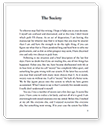Essay Instructions: Lesson 6 Discussion Forum: My American Identity
Identity is complex, it is not just nationality, it is gender, ethnicity, class, sexual orientation, size, ability, preferences... Whether you consider yourself 'American' or not, attending a US university ties each of our lives deeply to issues of American identity. Have you, then, seen yourself represented in the materials we have explored this quarter? We have tried to cover a great deal, but there is obviously so much we could not include because of constraints on time. You however are going to help us correct that. For your final Discussion Forum, we would like you to find a reference, a reading, a video, a youtube clip, a website, that refers to an example of dance that represents a part of you. You can find many other dances through Alexander Street Press.
******************(im an Asian and is an international student from China)**********************************
Paragraph 1:
Provide a brief description of what you found, highlighting issues of identity. Provide a link or other media as you see fit. Specifically address the elements of form, technique and structure as evidence.
Use the guiding questions below as a starting place, but be sure to develop your response beyond simple answers.
Form: How would you describe the movement of the dance to someone who had never seen it before? Be specific; what is the body actually doing? How do the feet, the legs, the hips, the ribs, the shoulders, the hands, the head move? How does music, clothing or costume, and location contribute to identity?
Technique: How does someone learn or teach this dance? What is the history of this dance? Did it develop from another dance? What is being passed on through teaching this dance?
Structure: Think here about the rules of the dance. Do you dance by yourself, or with one other person, or with many? What communities are involved or created? Who is allowed to dance and in what relationships are they arranged?
Paragraph 2:
Describe how this reference represents a part of your identity. Specifically refer to the elements of form, technique and structure as evidence. Remember that this post will be viewed by your classmates so share only what you are comfortable making public.
How does this dance fit with the concepts of American identity discussed so far? Does it relate to the:
Broadway themes (opportunity, abundance, optimism, pluralism)
Frontier/Puritan themes (individualism, democracy, anti-authoritarianism, functionalism)
American mythology, counter-mythology, continuum, or some other concept?
Compare this dance to another dance viewed in this course. For example, if your dance displays optimism, how does it display this trait differently than some of the 1920s musicals?


